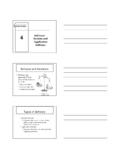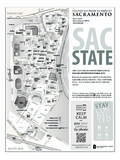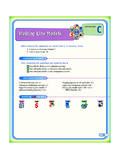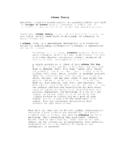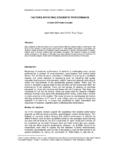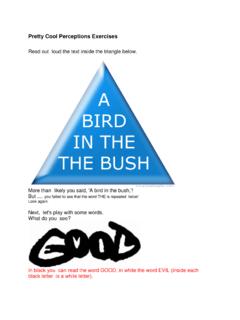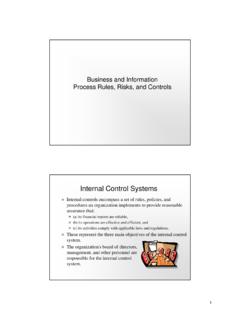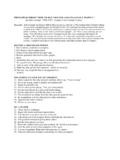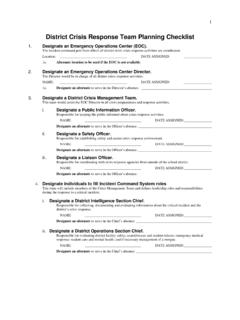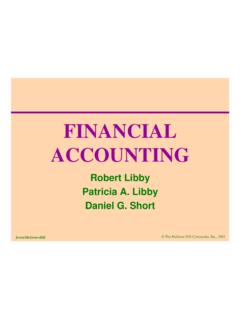Transcription of 9 Activity-Based Costing Solutions to Review Questions
1 1 9 Activity-Based Costing Solutions to Review Questions 9-1. Give examples of cost drivers commonly used to allocate overhead costs to products and services. Common allocation bases are direct labor-hours, direct labor costs, and machine-hours. Somewhat less common is direct material costs. 9-2. Give examples of cost drivers commonly used to allocate overhead costs to products and services. The term death spiral refers to a process that begins by attempting to increase prices to meet reported product costs. Higher prices reduce demand, leading to production and still higher reported product costs. Eventually, the firm loses products as the market will not support them and goes out of business. The death spiral is not the result of the cost system directly, but the result of managers making decisions (in this case raising prices) based on the cost system that is (often inaccurately) signaling increased costs.
2 9-3. Give examples of cost drivers commonly used to allocate overhead costs to products and services. False. Department allocation is a two-stage process, so the first-stage assignment of costs and the choice of cost drivers affects the allocation of costs to products. The total product costs are the same under either approach, but the individual product costs differ. This can affect the decisions managers make regarding individual products. 9-4. Give examples of cost drivers commonly used to allocate overhead costs to products and services. Most companies produce multiple products and simply adding them up does not account for differences in complexity of the use of resources. As an extreme example, suppose a company produced airplanes and staplers.
3 Allocating overhead on the basis of units would assign the same overhead cost to a stapler and a plane. 9-5. Give examples of cost drivers commonly used to allocate overhead costs to products and services. The costs include the systems and the software, but the most important cost is managers time. Managers need to make many decisions about the activities and the cost drivers and managers need to make many of the first-stage allocations. The benefits come from having better information about the use of resources and better information for decisions. 2 9-6. Give examples of cost drivers commonly used to allocate overhead costs to products and services. 1. Identify activities that consume resources. 2. Identify the cost driver associated with each activity.
4 3. Compute a cost rate per activity unit ( , rate per setup, rate per part, rate per machine-hour). 4. Allocate costs to products by multiplying the activity rate times the volume of activity consumed by the product. 9-7. Give examples of cost drivers commonly used to allocate overhead costs to products and services. The cost hierarchy is a classification of costs into general levels of activity. Costs assigned to the different levels of the hierarchy tend to be related to the volume of the activity volume. 9-8. Give examples of cost drivers commonly used to allocate overhead costs to products and services. False. While the total cost allocated is the same, the reported costs for individual products will differ.
5 Because managers make decisions at the product level, it is important that the reported costs reflect, to the extent possible, the use of resources by the products. 9-9. Give examples of cost drivers commonly used to allocate overhead costs to products and services. Activity-Based Costing will benefit most companies with high overhead costs and diverse products and processes. If there is little overhead or if there is a single product, the allocation process will not result in significantly different product costs. (Even if there are only a few, relatively homogeneous products, Activity-Based Costing may be useful for cost management. See chapter 10 for a discussion.) 9-10. In what ways is implementing an Activity-Based Costing system in a manufacturing firm's personnel department the same as implementing it in the plant?
6 In what ways is it different? A personnel department provides its services by completing a set of activities using resources. In this way, implementing Activity-Based Costing in an administrative function is the same as implementing it in a manufacturing firm. However, the products and activities may be much harder to define, making it less like a manufacturing environment. 9-11. How does complexity lead to higher costs? Why is it important for the cost system design to consider complexity? Complexity adds costs by requiring additional resources for overhead (support) activities for the same volume. It is important to include complexity in cost system designs to avoid spreading the cost of complexity across both simple and complex products.
7 3 9-12. What two Questions must a manager answer if a company is implementing time-driven Activity-Based Costing ? The two Questions a manager must answer when implementing time-driven Activity-Based Costing are (1) what is the cost of the resources supplied to a department and (2) how much time it takes to complete the various activities of the department. 9-13. In the context of time-driven ABC, what are time equations? Time equations allow managers to adjust the time required for activities for selected characteristics of products or services. 4 Chapter 9 Outline LO 9-1 Understand the potential effects of using reported product costs for decision making. REPORTED PRODUCT COSTS AND DECISION MAKING Dropping a Product o Managers may consider dropping a product if the reported costs of producing it have risen more rapidly than the price charged for it, and the product line margins have fallen to unacceptable levels.
8 The decision will be based on the impact it has on reported product costs. o Product costs are used primarily for developing inventory balances and cost of goods sold amounts for financial reporting. The basic approach to product Costing involves assigning direct costs to products and allocating manufacturing overhead costs to products. o If managers rely on the cost accounting system to make the decision to keep or drop a product, the cost system provides potentially inaccurate unit costs. Exhibit shows the assignment of costs to two products using an allocation base of direct labor hours; management is considering dropping the C-27s; the cost savings appear to be $198,400. The reported unit costs of C-20s will increase from $6,920 to $9,260, an increase of about 34 percent.
9 If the managers attempt to increase the price of the C-20s by an equivalent amount, the market is unlikely to accommodate it. As a result, they face two equally unappealing choices: Remain in business and lose money, or shut down. Exhibit shows the assignment of costs assuming that the C-27 is dropped and only the remaining product (C-20) is produced; the cost estimate for the C-20s increases from $207, 600 to $277,800. Exhibit provides the total product estimates with (totaling $406,000) and without the C-27s (totaling $277,800); the cost savings are only $128,200 (= $406,000 $277,800). o Once a predetermined overhead rate is calculated, it is applied as if all overhead costs were variable with respect to the allocation base, which is not true in most cases for two reasons: 5 Some of the overhead items could be fixed, and reducing the number of units produced does not result in lower fixed costs.
10 Examples of such fixed costs include cost of supervision, machine and plant depreciation, and miscellaneous items that do not vary with the allocation base. Some of the overhead items could vary, but with cost drivers other than those traditionally chosen ones. The Death Spiral o If managers attempt to recover the costs with a smaller number of units, they are likely to meet resistance in the market, resulting in demand for even fewer units. With the smaller production, the reported product costs increase even more. o The death spiral is a process that begins by attempting to increase price to meet higher reported product costs, losing market, reporting still higher costs, and so on, until the firm is of business.
